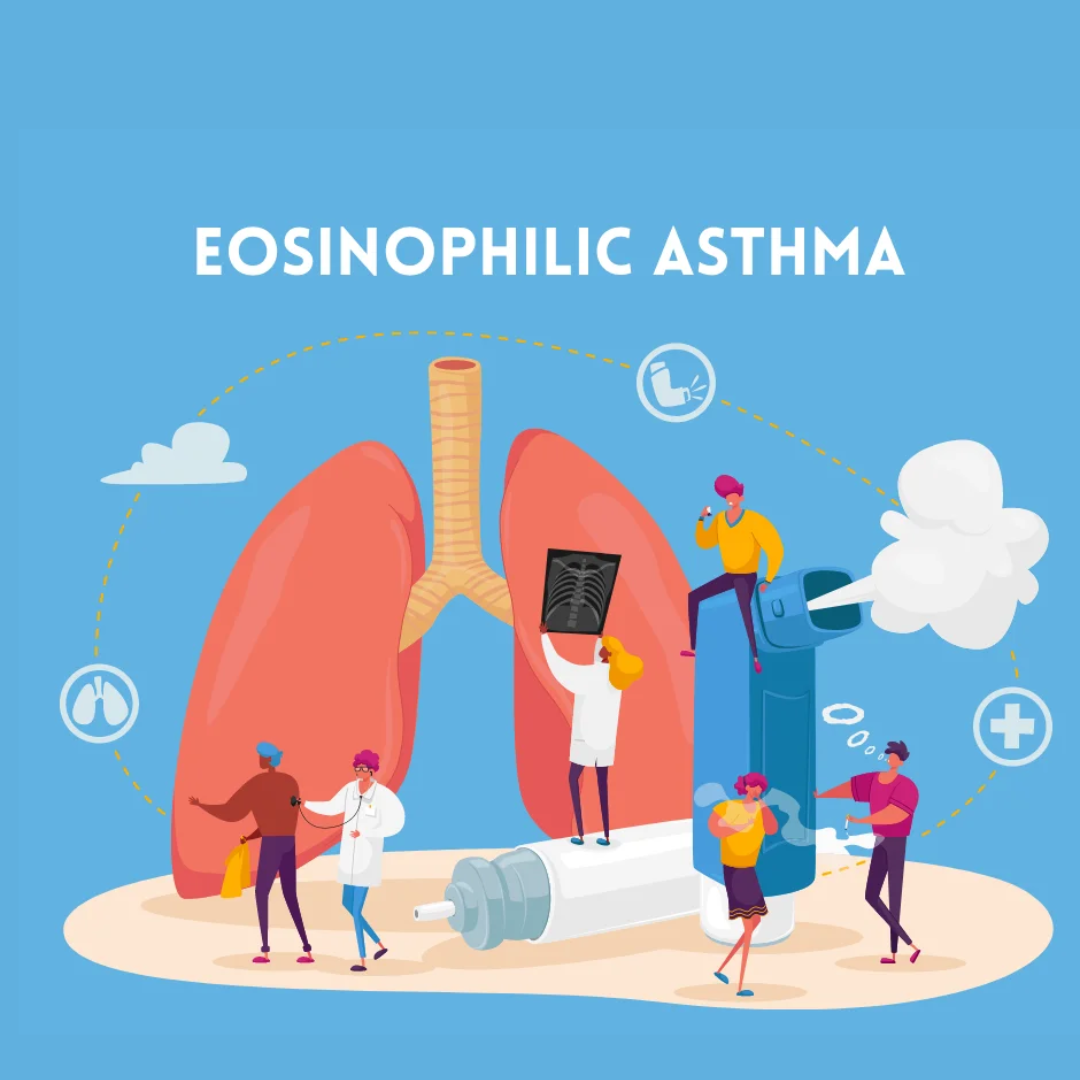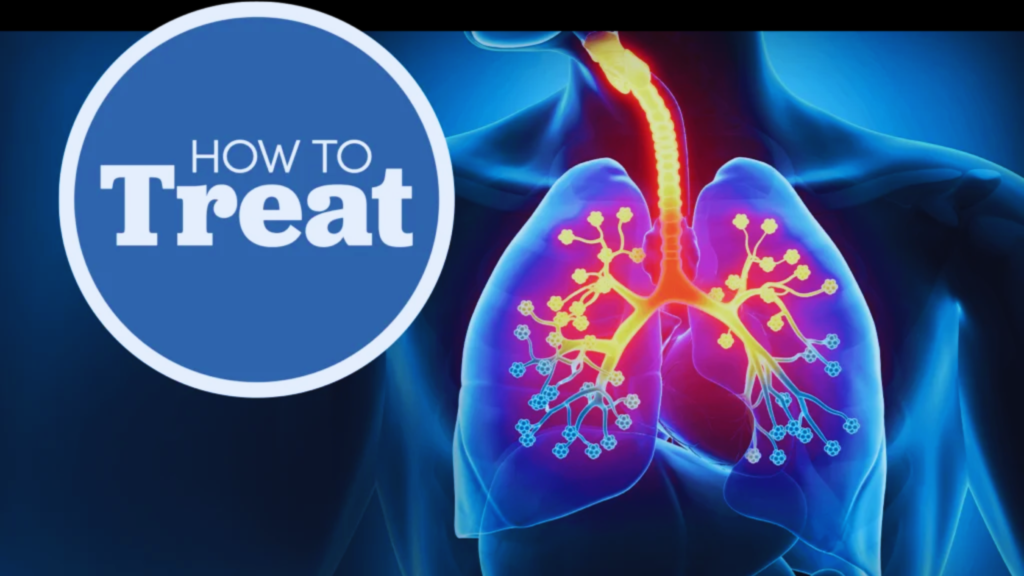
For a long period, doctors viewed asthma as a single disease. However, they now understand that it’s more complex. Asthma is now seen as a group of health conditions, varying in factors like the age of beginning, symptoms, and the most effective treatments. This is where eosinophilic asthma comes into play. It is identified as a subtype of asthma.
Researchers are still working hard to define this subtype, an important task that could lead to more effective treatments. Eosinophilic asthma is a major contributor to severe asthma, affecting 50%-60% of individuals with the severe form.
In this article, we’ll provide an overview of this type of asthma, which has led to new medications that are rapidly transforming the treatment landscape.
What Is Eosinophilic Asthma?

Eosinophilic asthma is a form of asthma triggered by increased levels of eosinophils, a type of white blood cell, in the lung airways. These blood cells are designed to help your body combat infections. However, sometimes, your body generates them in excess.
When this happens, they can become overactive and lead to inflammation throughout your body, including in your lungs. When eosinophil levels are high, the airways can become more swollen, leading to asthma symptoms. This type of asthma is severe and often results in more frequent asthma attacks.
Eosinophilic asthma generally begins in adulthood and may not respond well to inhaled corticosteroids, a common asthma treatment. Identifying the exact cause of this asthma can be challenging. While adult asthma generally affects less men than women, eosinophilic asthma occurs at similar rates in both genders.
Individuals with this type of asthma can experience non-allergic or allergic triggers. Other asthma types, like allergic asthma, are often triggered by certain allergens like environmental particles, pet dander, dust mites, and mold spores.
Eosinophilic asthma typically emerges in individuals aged 25 to 35. This disease can be tough to manage and might significantly impact a person’s quality of life.
What Causes Eosinophilic Asthma?
Doctors are still unsure about what triggers eosinophilic asthma. There are not any obvious factors, like diet or exercise habits, that increase the risk of developing it. While high eosinophil levels can occur when the body is battling a parasitic infection, scientists have yet to pinpoint why these levels rise in eosinophilic asthma cases.
Asthma often runs in families, so researchers are investigating a potential genetic link. However, no specific genetic connection has been identified for this type of asthma.
Symptoms of Eosinophilic Asthma

Common eosinophilic asthma symptoms are given below:
- Difficulty breathing or shortness of breath
- Obstructed airways
- Wheezing
- Coughing
- Chest tightness
Although these symptoms mirror those of other asthma types, they are often more severe and persistent in eosinophilic asthma. You also may experience more frequent and potentially dangerous asthma attacks. Asthma typically causes swelling in the lung’s airways.
However, this type of asthma leads to inflammation throughout the whole respiratory system, from the nose to the smallest airways. This is why shortness of breath, instead of wheezing, is a primary symptom of this asthma type. Even during physical activity, shortness of breath tends to worsen more than wheezing.
A clue that your asthma might be eosinophilic is if standard asthma treatments, like a medicine called inhaled corticosteroids, don’t work effectively. Oral corticosteroids often help, but they generally come with more side effects. In addition, if you have eosinophilic asthma, you might become reliant on corticosteroids to stop asthma attacks.
Eosinophilic Asthma Diagnosis
If you have been diagnosed with asthma but aren’t responding well to treatment, your doctor might suspect a rare type of asthma. They will likely assess your condition further and search for extra symptoms or signs to guide their diagnosis. For the diagnosis of eosinophilic asthma, the simplest step is to measure your white blood cell levels.
Your doctor will collect a sample of your saliva, blood, or sputum and send it to a lab. Elevated eosinophil levels can confirm your doctor’s suspicions. Besides the blood test, your doctor might also perform a physical test. Specific physical signs, like nasal polyps, can support the suspected diagnosis.
Together, the physical test and the blood test might provide enough information for your doctor to make a diagnosis. The signs of eosinophilic asthma are different from those of typical asthma and are actually more similar to chronic obstructive pulmonary disease (COPD).
Treatment of Eosinophilic Asthma

In the U.S., about 1 in 12 people is diagnosed with asthma. As doctors have come to understand that asthma encompasses various subtypes, they recognize the need for tailored treatments for each one. Customized treatments for each subtype can lead to better results for the disease.
Conventional asthma treatment typically contains a rescue inhaler and inhaled corticosteroids. However, those with eosinophilic asthma often don’t react well to inhaled corticosteroids. Even higher doses might become ineffective, necessitating a completely different treatment approach.
This is why doctors focus on quickly addressing the inflammation caused by this type of asthma and lowering the risk of severe inflammation in the future. By managing the inflammation, the side effects and symptoms of this asthma type can become less intense. The most common eosinophilic asthma treatments are given below:
Leukotriene Modifiers
Leukotrienes are your body’s compounds that work alongside eosinophils to trigger inflammation. Leukotriene modifiers help counteract this inflammatory response. Some commonly prescribed medicines in this category are zafirlukast (Accolate), montelukast (Singulair), and zileuton (Zyflo).
Corticosteroids
Inhaled corticosteroids aren’t effective for everybody, so your doctor might suggest taking them in pill form. However, corticosteroid pills can have more complications and side effects than inhalers, so it’s important to discuss this option with your doctor.
Biologic Therapy Options
These medication options target and block the chemicals responsible for swelling and inflammation in the body. They are given to you through an intravenous (IV) drip or an injection. For eosinophilic asthma, biologics like mepolizumab (Nucala) and omalizumab (Xolair) are commonly prescribed.
Fast-acting Inhalers
Rescue inhalers are often prescribed for individuals diagnosed with asthma. While they can be helpful to treat this kind of asthma, their effectiveness might diminish over time.
In What Ways Does Eosinophilic Asthma Impact Quality of Life?
If your asthma is uncontrolled, regardless of the type, you face a higher risk of hospitalizations, emergency room visits, or even death. Those with severe asthma may experience daily symptoms and require more frequent emergency care compared to individuals with well-managed asthma.
Severe asthma can make even simple tasks challenging, be debilitating, and reduce your overall quality of life. Identifying the specific subtype of severe asthma, such as eosinophilic asthma, is crucial for effectively treating uncontrolled asthma.
A 2017 study by the Asthma and Allergy Foundation of America (AAFA) revealed that individuals with uncontrolled, severe asthma endure greater financial, emotional, and social burdens. However, many people with uncontrolled, severe asthma are unaware of their specific asthma type.
They may also not know that biological treatments are available that could better manage their condition and enhance their quality of life. So, it’s important to be aware of this issue and discuss it with your doctor. If you have eosinophilic asthma, talk to your healthcare providers about how it negatively impacts your daily life.
Share your treatment goals and ask if you might be a candidate for biological asthma treatments. Whenever possible, consult a board-certified pulmonologist or allergist. I also encourage doctors to collaborate closely with their patients to understand the various ways eosinophilic asthma affects the quality of life.
Discuss the particular risks and advantages of potential treatments. By working together, individuals with asthma and their doctors can develop a mutual understanding of how to manage asthma and set treatment goals.
Final Thoughts
Although the link between eosinophils and asthma has been recognized since 1889, researchers are still exploring the most effective treatments for eosinophilic asthma. The development of new therapies has greatly improved the outlook for those with this condition.
Individuals with this condition often experience frequent inflammations and may rely heavily on oral corticosteroids, which come with severe side effects. In severe cases, the disease can be life-threatening. Fortunately, with new treatment options, this doesn’t need to be the case.
It’s crucial for people with eosinophilic asthma to adhere to their treatment plans and practice daily self-care to maintain optimal health.
